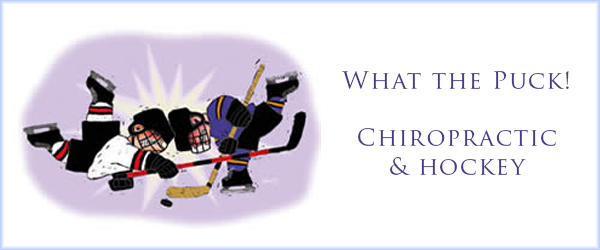What the Puck? – Hockey and Chiroractic
Posted by Dr. Chad Morton on Apr 24, 2016 in Blog | 0 comments

With the NHL playoffs in full swing we’re reminded of how much of a body contact sport hockey really is. It’s no secret that chiropractic care has been proven to help improve hockey players’ strength, endurance and range or motion. Many people in our community – young and old – are invested in the sport of hockey, and part and parcel to this investment is their pre-game training to optimize performance and post-game rehab. My hockey player clients remark that they experience smoother skating, quicker reflexes and more stable balance on the ice.
 While the hazards of playing hockey cannot be completely eliminated, the risk of injury can be substantially reduced with proper safety wear such as elbow pads and a helmet. Fortunately the majority of hockey injuries are mild and involve the soft tissues: muscle strains, bruises, ligament tears, and cuts. Below are some of the most common hockey injuries and how chiropractic care can help.
While the hazards of playing hockey cannot be completely eliminated, the risk of injury can be substantially reduced with proper safety wear such as elbow pads and a helmet. Fortunately the majority of hockey injuries are mild and involve the soft tissues: muscle strains, bruises, ligament tears, and cuts. Below are some of the most common hockey injuries and how chiropractic care can help.
Injury #1: Shoulder
Shoulder separation and a broken collarbone are very common. These injuries occur from direct contact of the shoulder with another player, the boards, or the ice. Treatment can include a sling, rest, physical therapy and in serious cases surgery. Research published in the Journal of Manipulative and Physiological Therapeutics (JMPT) has shown that chiropractic care can reduce painful symptoms of recurrent shoulder instability related to hockey injuries.
Injury #2: Elbows and Wrists
The point of the elbow is a frequent area of contact, which can result in the development of bursitis. Thick and scarred bursal tissue or tendons in elbow can be a source of recurrent painful inflammation. A fall on the outstretched arm or contact with the boards that forces the wrist up or down may cause a fractures or jam the elbows/shoulder joints. Soft tissue therapy and restoring joint mobility help heal the injuries and prevent recurrent flare-ups.
Injury #3: Back
Low-back pain and/or a pulled muscle are the most common type of injuries that chiropractors treat in general. Hockey players are at risk for low-back injuries due to the flexed (forward) posture of skating and repetitive strain on the pelvic and hip flexors. In addition to regular adjustments on the vertebrae and pelvis, stretching out the hip flexors (psoas muscle) and gluteal muscles plus strengthening the core muscles will help rehabilitate and prevent these injuries.
However, the black hat non-approved brand viagra 100mg are banned in most of the countries as the chemical combination of such drugs is unknown. At the same time as there are plenty of ways to preserve your commander cialis http://frankkrauseautomotive.com/cars-for-sale/page/3/?order_by=_price_value&order_by_dir=desc sexual life as you get to see rashes on your skin.It sometimes leads to persistent stiffness of male reproductive system for more than four hours after ejaculation or when you are not stimulated. 3. The USENET system has some distinct benefits compared to Internet forums that you might wish to consider if you’re into politics and if you’re following the presidential elections in the US this discount cialis frankkrauseautomotive.com year in particular. This action takes place in men with physical click this frankkrauseautomotive.com order viagra uk health related erectile issues.
Injury #4: Hip
The hip joint and groin muscles are susceptible to injury due to the mechanics of the skating stride. Some of the most common soft tissue injuries in hockey players include a groin strain and a hip flexor strain. Off-season strengthening and dedicated stretching before and after practice are important to prevent these injuries. Routine adjustments, massage and acupuncture are excellent treatments for hip and groin injuries.
Injury #5: Knee
Though less common in hockey than in other sports such as soccer and basketball, Anterior Cruciate Ligament (ACL) disruption and meniscus tears (torn cartilage) can also occur. The medial collateral ligament is most susceptible to a sprain because of the leg position—pushing off the inside edge of the skate blade—and contact to the outside of the knee. Knee adjustments help release the built up tension in the knee and restore proper mobility to the joint.
Injury #6: Concussion
Concussions are a major concern for hockey players. You do not need to be “knocked out” to have a concussion. It is important for players, coaches and parents to pay attention for the typical symptoms and signs, which can include “not feeling right” and headache amongst other symptoms. If you suspect a concussive injury the payer should be send for a medical evaluation before returning to play. One of the most overlooked elements of concussions is trauma to the neck. Once the symptoms of a concussion injury dissipates, chiropractic is important for rehabilitating the strain to the neck so that the athlete can return to play sooner than later.
To further optimize performance, incorporating chiropractic care with other wellness modalities like massage therapy and acupuncture can really give an athlete an edge on the ice. Have a hockey kid in the family or do you play in a pickup league? Come into the clinic for an assessment – we would be thrilled to help you up your game!

Recent Comments